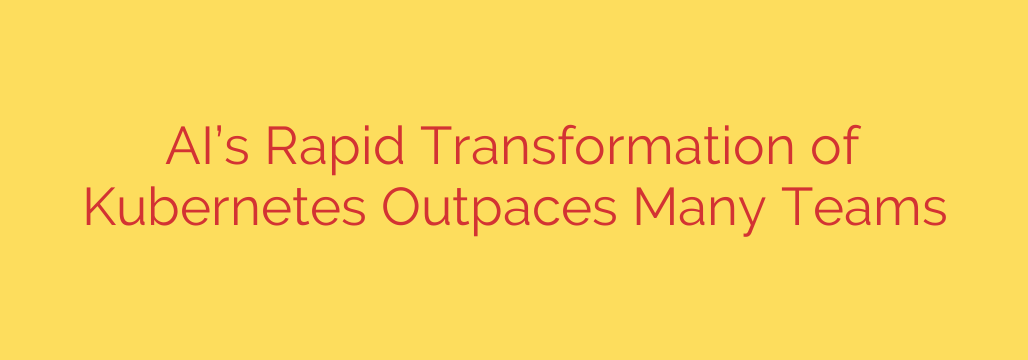
Navigating the AI Wave: Is Your Kubernetes Environment Keeping Up?
The worlds of Artificial Intelligence (AI) and cloud-native computing are colliding, with Kubernetes standing firmly at the epicenter. As organizations rush to deploy sophisticated machine learning (ML) models, they are turning to Kubernetes as the de facto standard for scalable and resilient infrastructure. However, this rapid convergence is exposing a critical problem: the breakneck pace of AI innovation is fundamentally reshaping the demands on Kubernetes, and many teams are struggling to keep up.
The reality is that running AI workloads is vastly different from managing the stateless applications Kubernetes was originally designed for. This mismatch is creating significant challenges in complexity, cost, and security that can stall projects and drain resources.
The New Demands of AI Workloads
Traditional DevOps practices and Kubernetes configurations often fall short when faced with the unique needs of AI and ML. The challenges are not minor tweaks but fundamental shifts in how infrastructure is managed.
First and foremost are the hardware requirements. AI models, especially during training, are incredibly resource-intensive. This creates a new dependency on specialized and expensive hardware.
- Specialized Hardware: AI workloads require access to powerful Graphics Processing Units (GPUs), Tensor Processing Units (TPUs), and other accelerators. Effectively scheduling, sharing, and monitoring these resources across a cluster is a complex task that standard Kubernetes schedulers are not inherently optimized for.
- Massive Data Throughput: Machine learning models are fueled by enormous datasets. This means your Kubernetes environment must be architected for high-throughput data pipelines, demanding robust storage solutions and high-speed networking that can handle terabytes or even petabytes of data without creating bottlenecks.
- Complex Job Orchestration: Unlike a simple web server, training an AI model is often a multi-stage process involving data preparation, training, validation, and deployment. These long-running, stateful jobs require advanced orchestration capabilities to manage dependencies and ensure successful completion, pushing the boundaries of standard Kubernetes workflows.
The Widening Skill Gap and Operational Strain
Beyond the technical hurdles lies a significant human challenge. The expertise required to manage a production-grade Kubernetes environment is distinct from the skills needed to build and train effective AI models. This often creates friction and inefficiency.
A significant skill gap is emerging between traditional DevOps teams and the data scientists deploying AI models. DevOps and platform engineers are masters of infrastructure, reliability, and automation, but may lack deep knowledge of ML frameworks and GPU optimization. Conversely, data scientists understand the models but are often not experts in containerization, networking, or infrastructure-as-code.
This divide places an immense strain on platform teams, who are now expected to support a completely new class of workload. Without the right tools and platforms, they become a bottleneck, manually configuring environments and troubleshooting complex issues that slow down the entire AI development lifecycle.
How to Prepare Your Kubernetes Strategy for AI
Staying ahead of the AI curve requires a proactive, strategic approach to evolving your Kubernetes platform. Simply reacting to problems as they arise is a recipe for falling behind. Here are actionable steps to build a future-ready environment.
Embrace MLOps and Platform Engineering Principles
Your goal should be to build an internal platform that abstracts away the underlying complexity of Kubernetes from data scientists. By providing a “paved road” with self-service tools for model training, data management, and deployment, you empower your AI teams to work efficiently without needing to become Kubernetes experts. This is the core of a successful MLOps (Machine Learning Operations) strategy.Invest in AI-Aware Tooling and Automation
Relying on a generic Kubernetes stack is no longer sufficient. You need to augment your environment with tools specifically designed for AI workloads. This includes investing in intelligent schedulers that can optimize GPU utilization, implementing cost management tools to track and control the high cost of specialized hardware, and automating the entire ML lifecycle, from code commit to model deployment.Prioritize a Unified and Modern Security Posture
AI introduces new security risks. Models can be poisoned, and the large datasets they use are prime targets for exfiltration. Your security strategy must evolve to protect the entire AI pipeline, not just the container. This involves scanning ML libraries for vulnerabilities, securing data in transit and at rest, implementing strict access controls for sensitive datasets, and monitoring models in production for anomalous behavior.Foster Cross-Functional Collaboration
Break down the silos between DevOps, data science, and security. Create cross-functional teams dedicated to the MLOps platform. When infrastructure experts and AI experts work together, they can co-design a system that is both powerful and practical, ensuring the platform meets the real-world needs of its users.
The integration of AI and Kubernetes is not a passing trend; it is the future of enterprise technology. The organizations that succeed will be those that recognize the unique challenges AI presents and strategically invest in the platforms, tools, and skills needed to overcome them. By taking these steps now, you can transform your Kubernetes environment from a potential bottleneck into a powerful engine for innovation.
Source: https://www.helpnetsecurity.com/2025/08/14/ai-in-kubernetes-operations/








